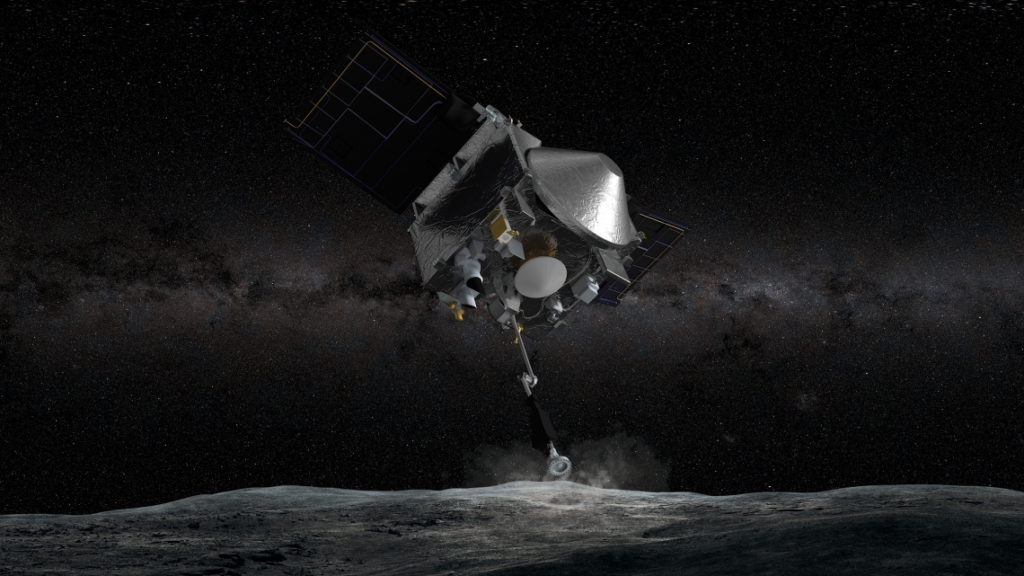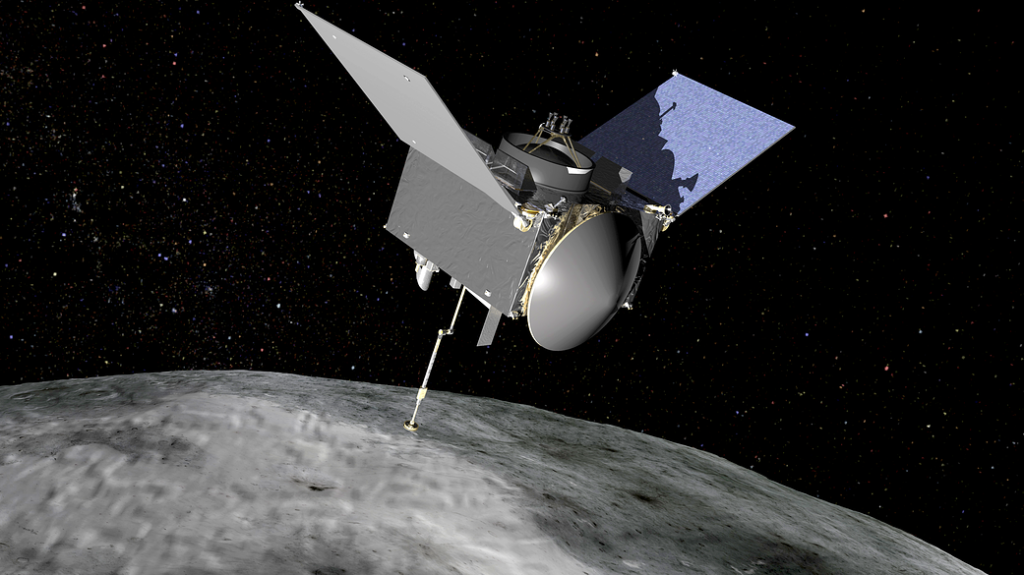
NASA Just Returned Asteroid Samples For The First Time
Earlier this morning after 7 years of traveling space, NASA returned its first asteroid samples back to Earth. Back in 2016, NASA launched its first ever asteroid sample return spacecraft. Years later in 2021 it made contact with an asteroid Bennu, collecting rock and starting its journey back to Earth. Finally, after all that time the sample successfully landed on Earth after reentering the atmosphere. Now the agency will take a closer look at these one of a kind samples to determine a host of new information.
This marks the first U.S. mission to deliver a sample of an asteroid to Earth. The samples are expected to help scientists investigate how planets formed and how life began, as well as improve our understanding of asteroids that could impact Earth. When the spacecraft first made contact, it actually grabbed more rocks and dust than expected.
Either way, it’s now heading to various labs to be tested and inform future decisions. Here I will go more in-depth into the landing this morning, why it’s so significant, the long journey of this mission, and more.
Safe Landing

After launching in 2016, we got video years later in 2021 when the spacecraft made quick contact with an asteroid named Bennu. Here you can see the spacecraft’s arm touch the surface for a second shooting up a bunch of debris before bouncing away from the asteroid. In the quick interaction, the spacecraft managed to gather and store around 8.8 ounces, or 250 grams of material. It then began its long journey back to Earth, which it finally reached this morning.
As the spacecraft was passing Earth, it deployed its mini fridge size capsule containing the asteroid samples. Specifically, OSIRIS-REx released the capsule at 8:42 a.m. EDT while it was still 63,000 miles from Earth. Interstingly, the spacecraft then fired its engines to divert away from Earth and is now headed off to a different asteroid, which it will reach in 2029. As for the capsule, a few hours went by as it got closer and closer to Earth.
By 10:46 a.m., the sample capsule had entered Earth’s atmosphere and began streaking toward its landing site. Only minutes earlier NASA reported that the 1st two recovery helicopters were in the air awaiting OSIRIS-REX’s approach and landing. Around 8:49 a.m., the sample return capsule had deployed its main parachute and was drifting toward Earth. It deployed the main parachute at 5,000 feet. Finally, at 10:52 a.m., the capsule touched down in the Utah desert. The NASA livestream showed mission teams cheering after the successful landing.
Right after the landing NASA tweeted saying, “TOUCHDOWN! The #OSIRISREx sample capsule landed at the Utah Test and Training Range at 10:52am ET (1452 UTC) after a 3.86-billion mile journey. This marks the US’s first sample return mission of its kind and will open a time capsule to the beginnings of our solar system.” It’s important to point out that with the sample now on the ground, NASA has to make sure there is no contamination. Because scientists will look for organic molecules related to life in grains of Bennu, it is critical that the sample doesn’t get exposed to Earth’s environment, including its life. Such contamination would make it hard for scientists to distinguish which molecules came from space and which came from Earth.
As the sample capsule descended through Earth’s atmosphere, air entered through its vents, streaming in through a filter that removed contaminants including water vapor, organic compounds, and dust. It then flows into a canister inside the capsule that contains the sample. This allows the canister to come to atmospheric pressure, which will protect it from leaks that could lead to contamination.
Now that the capsule has landed, it will be retrieved, and delivered to a temporary clean room at the Utah Test and Training Range. Here the OSIRIS-REx team will hook it up to a tank that will release nitrogen, a gas that doesn’t interact with most other chemicals. A continuous nitrogen flow into the capsule will push out invading air. Tomorrow, on Sept. 25, the mission team will transport the sample to NASA’s Johnson Space Center in Houston, where it will be documented, cared for, and stored. Soon after, portions of Bennu’s rocks and dust will be distributed to scientists on the mission’s science team, NASA’s partners from the Canadian and Japanese space agencies, and researchers around the world. A small part of the sample will also be stored in White Sands, New Mexico, for safekeeping.
Mission Overview

While today was just the landing, the process and time to get that sample required some incredible engineering. OSIRIS-REx is the third major planetary science mission for NASA’s New Frontiers Program (after New Horizons launched in 2006 and Juno launched in 2011). OSIRIS-REx is an acronym for “Origins, Spectral Interpretation, Resource Identification, Security-Regolith Explorer.” The goal of the mission was to collect a sample weighing at least 2.1 ounces (59.5 grams) from a near-Earth asteroid.
About 55 minutes after launch on Sept. 8, 2016, from Cape Canaveral, Florida, and after a boost by the Centaur upper stage, OSIRIS-REx separated from its Atlas V rocket and deployed its solar arrays. The spacecraft’s trajectory correction maneuver (TCM) thrusters were fired for 12 seconds for the first time on Oct. 7, 2016, for a course correction. The spacecraft got its first glimpse of Bennu in August 2018, sending back a grainy image taken at a distance of about 1.4 million miles (2.3 million kilometers). In early November 2018, OSIRIS-REx sent back detailed images showing the asteroid’s shape and some surface features.
After arriving at Bennu on Dec. 3, 2018, OSIRIS-REx mapped the asteroid in detail while the mission team searched for a safe sample collection site. One of the biggest challenges was that Bennu has an extremely rocky surface with hazardous boulders. After a year, the mission team selected a sample site called “Nightingale” located in a northern crater 460 feet (140 meters) wide. The crater is thought to be relatively young, and the regolith, or rocks and dust, is freshly exposed. This means the site would likely allow for a pristine sample of the asteroid, giving the team insight into Bennu’s history.
On Oct. 20, 2020, OSIRIS-REx unfurled its robotic arm and, in a first for NASA, briefly touched down on asteroid Bennu to collect dust and pebbles from its surface in a maneuver known as “Touch-And-Go” or TAG. Two days later, the mission team received images that confirmed the spacecraft had collected more than enough material to meet one of its main mission requirements. On Oct. 28, 2020, the mission team sent commands to the spacecraft, instructing it to close the Sample Return Capsule – marking the end of one of the most challenging phases of the mission.
On April 7, 2021, OSIRIS-REx completed its last flyover of Bennu and started slowly drifting away from the asteroid. During the flyby, OSIRIS-REx imaged Bennu for 5.9 hours, covering more than a full rotation of the asteroid. It flew within 2.1 miles (3.5 kilometers) of Bennu’s surface – the closest since the TAG sample collection event. Images taken during the flyover revealed the aftermath of its encounter with the asteroid.
In May, the spacecraft fired its main engines at full throttle for seven minutes – its most significant maneuver since it arrived at Bennu in 2018. This burn thrust the spacecraft away from the asteroid at 600 miles per hour (nearly 1,000 kilometers per hour), setting it on a 2.5-year cruise toward Earth. After orbiting the Sun twice, OSIRIS-REx finally reached Earth today.
The specific asteroid that the spacecraft made contact with was chosen for a few reasons. The asteroid is a remnant from the formation of the solar system, unlike any rocks we can find on Earth. NASA highlighted that “On our planet, weather, erosion, and plate tectonics have wiped away evidence of Earth’s formation. Thus, Bennu’s rocks offer us insight into our own history – a time about 4.5 billion years ago when Earth was first forming. Bennu is rich in organic compounds that make up all known life. There is evidence that asteroids like Bennu delivered these compounds to Earth when they smashed into our planet billions of years ago when the conditions for life were starting to emerge. Scientists want to learn more about this early period, and samples of a well-preserved asteroid could help them do that.”
Most asteroids can be found in the asteroid belt, a ring of asteroids that circles the Sun between the orbits of Mars and Jupiter. However, the asteroid belt is very far away, so a round trip would take a long time and be much harder to do. Bennu, in contrast, crosses Earth’s orbit, so it was easier and quicker to send a spacecraft to Bennu and back.
As far as possible impacts, NASA made it clear that Bennu has no chance of hitting Earth through the mid 2100s. After that, the chance is very slight, 1 in 1,750, or less than one-tenth of a percent, through at least the year 2300. In the distant future, Bennu could potentially hit Earth or even Venus, but that cannot be predicted with any accuracy. Indeed, being able to accurately predict the future motions of asteroids like Bennu is one of the science goals of the mission.
Conclusion
After around 7 years of space travel, NASA finally received an asteroid sample from the OSIRIS-REx mission. This morning the sample successfully entered Earth’s atmosphere before landing in the Utah desert. Now the agency will prepare for a host of testing and different experiments. We will have to wait and see how it progresses and the impact it has on the space industry.
